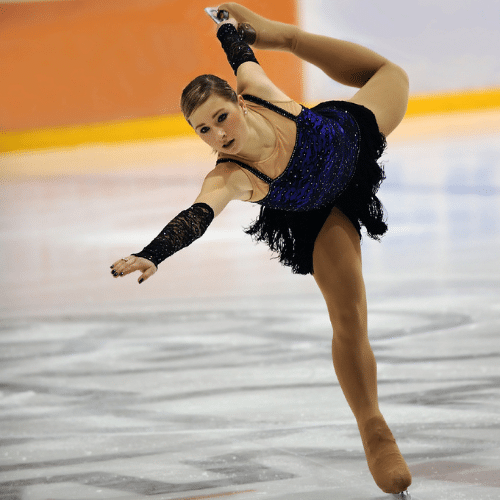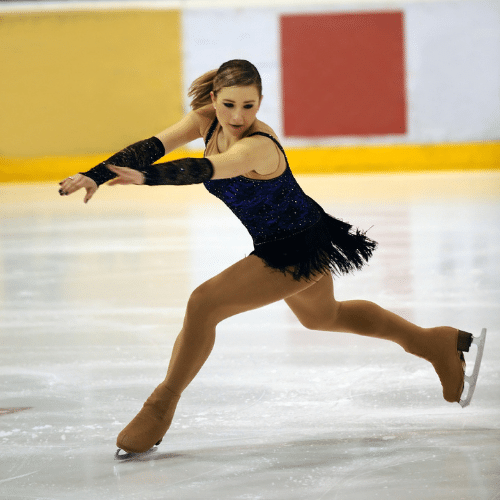Presented by Donna Burden Flowers, PT, ATC
USFS Sports Medicine and Science Committee, High Performance Subcommittee
By Interactive Metronome - January 18, 2024
Interactive Metronome® keeps Susan off thin ice and chasing her dreams.

Susan has been skating since she was 3 1/2, and seriously since she was 6, moving progressively up the US Figure Skating ladder of competitions. She successfully made it to the National level several times over the years, and at 15 as a Junior Ladies competitor, she started placing on the podium at her first International events.
Even with all this success, Susan had a difficult time with her growth, overuse injuries, and she never consistently maintained more difficult triple jumps. She had been using a wide variety of tools and modalities to improve her edge control, jump consistency, spin speed, and technique to progress from Junior Ladies to the Senior, or Olympic, level. These included Pilates, medicine balls, video analysis, physical therapy, Rolfing, core stabilization exercises, and a daily diet of stretching and functional training for her sport. In addition to her off-ice program, Susan skated 4 hours a day with world class coaches.
Although I was her physical therapist and certified athletic trainer for many years, I had not been introduced to Interactive Metronome® (IM) as a tool for the athletic population. When I suggested it to Susan’s family they were shocked that in that same week their son’s swim coach had suggested a kind of metronome timing system for their National swimmers. They wholeheartedly agreed.
Interactive Metronome® is an engaging therapeutic modality that improves cognitive and motor skills by working on your brain’s natural timing and rhythm. Research shows that engaging whole body movements in combination with cognitive tasks leads to overall better outcomes. Incorporating IM into a client’s training can more efficiently target this timing deficit, leading to more substantive gains in brain function. IM is a patented and unique training tool that challenges thinking and movement simultaneously, providing real-time millisecond feedback to help synchronize the body’s “internal clock.”
Both the Short and Long Form Assessments confirmed what I had thought about Susan’s sequencing and timing when setting up for a triple jump…she was early or very early over 90% of the time on the IM standard tests! She then confided that in order to do the consistent triples she counted 1-2-3-jump so she wouldn’t “ruin” the take-off.
I gave Susan a custom task involving the exact moment that she jumped off the ice for a triple loop jump, with technical help from her coaches. This set up of technique took about 45 minutes and was important to exactly mimic the technique on the ice as she jumped up. I used the button trigger which she hit to her chest as she pulled her arms into the jump at a rate of 30 beats/minute as a marker. In this way she had to create the right motor pattern over and over, which in itself was good training; again, the IM results showed her tendency to “rush” the take-off, as she was early or very early most of the time. Susan was exhausted and sweating after this intensive work involving auditory and visual focus, sequencing and timing of a correct motor pattern. She was, like every high level elite athlete, frustrated with herself and impatient to fix this.
Susan used visual and auditory feedback with this custom triple loop task at 30 beats/minute. She continued the hand clap and heel strike regular training for a total of 5 minutes for each of the 3 tasks, all in 1 minute intervals and at 54 beats/minute. She did this for 2 days after the initial set up day. On the third day, she landed 4 out of 10 triple loops, something she had never done before, and her confidence soared. She screamed:
“I KNOW WHAT TO DO NOW!
I CAN FEEL IT!”
Needless to say, Susan is using the IM-Home unit 5 days a week. She continues to do the hand clap and heel strike tasks also. Now, Susan is on cloud nine and can begin to recognize each step of her custom motor pattern task on the ice during the split second she has prior to exploding off the ice for the jump, making room for the right choice instead of the habit to be early and rush!
Susan had been trying for one full season to land her triple flip in competition. She was about 50% successful in practice, and the inconsistency was related to her pelvic control, or the ability to align her core muscles in the abdominal wall, pelvis and hips symmetrically. When she did, chances were good that she would land the jump. But, it seemed that the success of her triple flip related too much to chance and not to sequencing, timing, and muscle memory, even though she had been working on the jump for over a year. Whether an elite athlete like Susan, or a developmentally delayed child, core control is an important factor in motor patterning.

When Susan received a great deal of early success with the IM training for her triple loop (see front), she was keen to try the IM on her triple flip take off. The problem was, to train her pelvis and hips, where should the trigger be placed? We started working on the trigger placement with her coaches, and tried the tap mat. Susan put her “toeing off foot”, the foot that reached back and vaulted her up into the air, on the IM tap mat. At the sound of the cowbell she sprang off the vaulting foot and tried to level her pelvis and hips, at the same time contracting her lower abdominal muscles. But she had no way of knowing if she had done it correctly or not during the vault, and could only tell once she was in the air, which was too late to fix it.
We then moved the button trigger to her hand, and with the cowbell she was instructed to vault off her foot and pull into air position with her arms, hitting the trigger to her chest as she did. Again, this was not the correct placement for the trigger as she concentrated on her arms and upper chest position and did not sequence or coordinate her upper body with her hips and pelvis. The third option directly involved her right lower abdominals and pelvic/hip musculature, which seemed to be shifting consistently more to the right during her takeoff attempts with her right foot vault.
I taped a trigger to the wall directly in line with where her right hips would be at the moment of vaulting if she stood next to the wall to perform the task, and asked Susan to hit the trigger with her right hip as she heard the cowbell. All kinds of things happened as she fought to correct her lopsided attempts. The trigger was pulled off the wall at one point. Other times, she missed the trigger altogether. It was clear that this was the missing link to her awareness. Susan had no idea how far off her hips and pelvis really were until this very specific IM task.
It became increasingly difficult for Susan to focus after only a couple of one minute repetitions, so I set her up the next day with the IM-Home unit, a wall for the “hip” trigger with a mirror in front of it, and a computer stand for her to visually get feedback from IM as she performed. I instructed her to use both visual and auditory feedback, but gave her the choice during the task to choose either, both, and/or the mirror to watch herself. In this way Susan instinctively could choose to switch from audio to visual to mirror, or to use all of them during any part of her custom task training for pelvic control.
Susan was given her regular hand clap and heel strike tasks, as well as this custom task, with the goal of changing her ms average for each task from the 30s to the teens, and of changing her 90% early/very early habit to 50%. She performed the 3 tasks on the IM-Home 4 days a week, each of the 3 tasks for 5 minutes, in one minute intervals. She had to do each task, including the custom one, at 54 beats/minute.
After week one the best ms average for an individual task ranged from 24.85 to 32.81 with about 75% recorded early. The second week Susan’s lowest ms average ranged from 25.48 to 32.01 and she was still about 75% early. I asked her to not change the program for two more weeks as I wanted to see some real changes, and she was competing the triple flip in a competition the next weekend.
The third week she emailed me her results, 22.70 to 17.98 ms average with the lower number being the pelvic/hip custom task for the triple flip jump, with that task and the heel strike only 60% early. I immediately emailed back that her flip looked really promising. Within an hour I got a response:
“I NAILED THAT FLIP!”
Susan had landed a triple flip in competition for the first time in her career!

